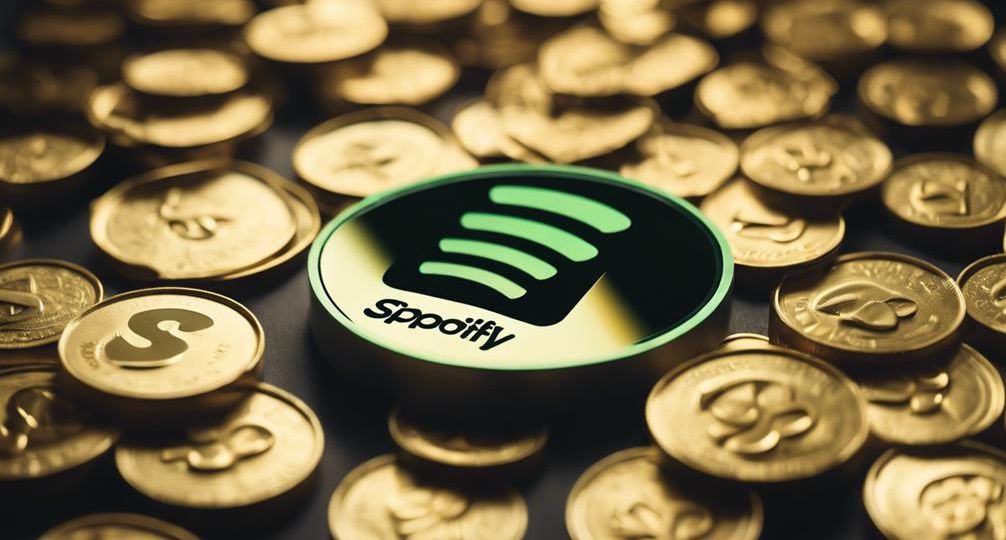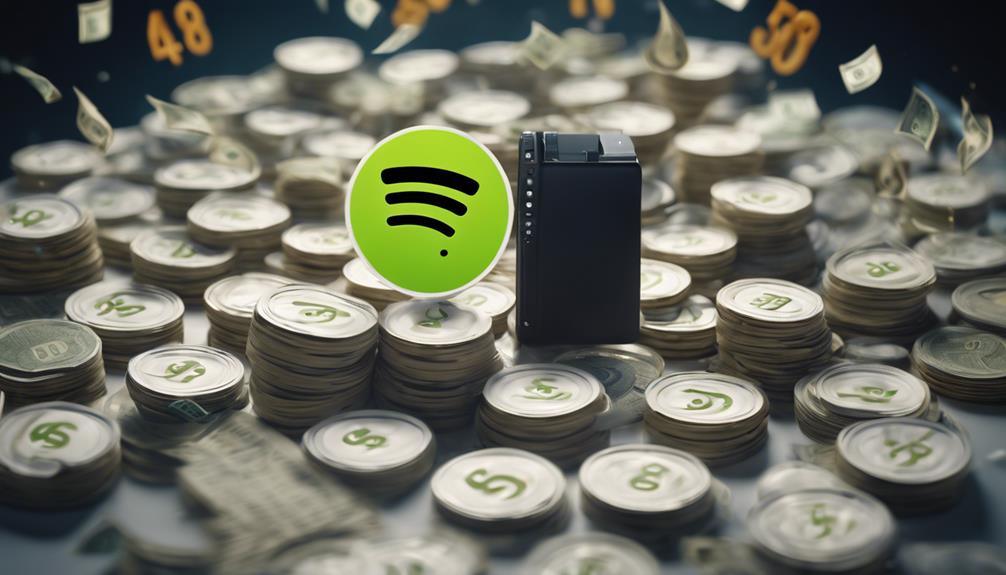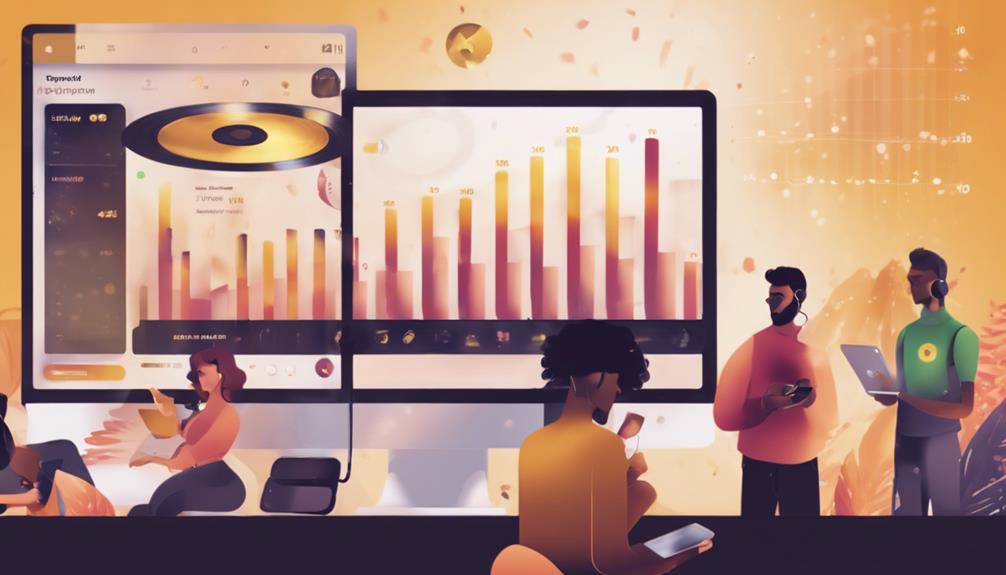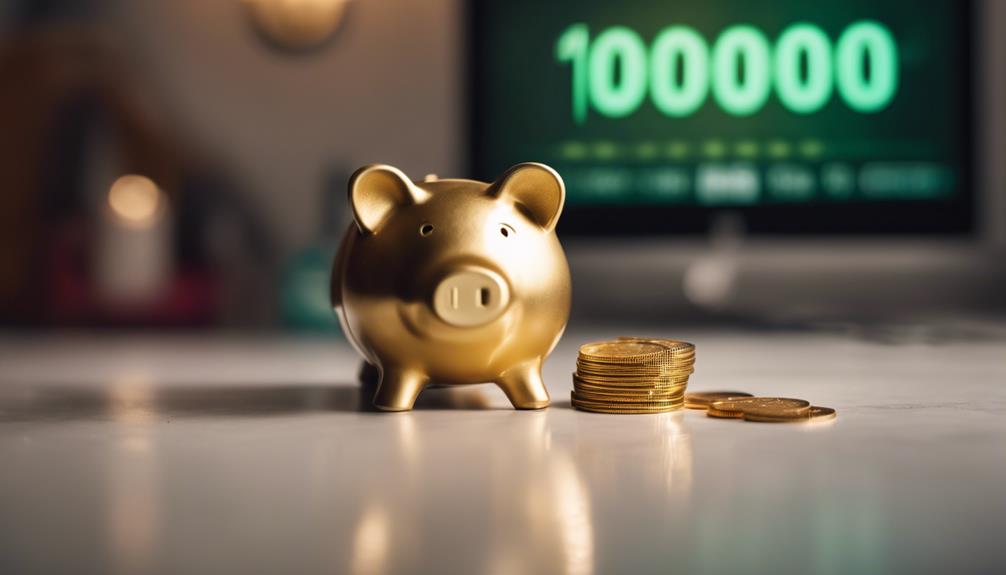
How much is 1000000 plays on Spotify?
If you rack up a million plays on Spotify, you can expect to earn between $3,000 to $5,000. Your actual earnings depend on various factors such as listeners’ subscriptions types, geographic locations, and Spotify’s complicated pro-rata model. Remember, improving user engagement and strategizing your music releases in key markets could potentially increase your earnings further. Understanding Spotify’s ecosystem and how streaming algorithms calculate your share is crucial for profitability. There’s more insight to gain from exploring how distribution deals and regional royalties may affect your earnings on Spotify.
Key Takeaways
- One million plays on Spotify could potentially earn an artist between $3,000 to $5,000, depending on various factors.
- Spotify’s per-stream payout typically ranges between $0.003 and $0.005, calculated using a pro-rata model.
- Factors affecting earnings include the listener’s geographic location, user subscription type, and total revenue in a given month.
- Earnings per stream also depend on the artist’s distribution deal, which determines the royalty percentage received.
- The artist’s visibility on the platform, influenced by streaming algorithms and user engagement, can impact total stream count and earnings.
Understanding Spotify’s Payment Structure

To grasp how much one million plays on Spotify could net you, it’s crucial to first understand Spotify’s unique payment structure, which is rooted in a per-stream payout model. Fundamentally, Spotify distributes around 70% of its total revenue to rights holders, who are typically record labels, producers, and, of course, artists themselves. These payouts are then divided according to the proportion of total streams that each artist’s music garners.
The exact per-stream payout can vary and is influenced by several factors, including the listener’s country and their subscription type. However, it’s generally estimated to be between $0.003 and $0.005. Now, if you crunch the numbers, you’ll find that one million plays could potentially earn you anywhere from $3,000 to $5,000.
Understanding Spotify’s streaming algorithms can offer you strategic insights to boost your artist royalties. The algorithm favors tracks that keep listeners on the platform, thereby increasing the chances of your music being included in personalized playlists. By grasping these intricacies, you’re armed with the knowledge to navigate the landscape of Spotify royalties more effectively.
Factors Influencing Spotify Payouts
Delving deeper into Spotify’s payout structure, you’ll find several factors at play that can greatly impact your earnings from streaming. Streaming algorithms and royalty calculations are key elements that shape Spotify’s payout policies.
Firstly, the streaming algorithms are designed to prioritize user engagement. So, the more your songs are listened to and shared, the more visibility they gain on the platform. This could lead to an increase in your streams and subsequently, your payouts. Hence, maintaining active engagement with your audience is crucial to optimize your reach.
Moreover, Spotify’s royalty calculations are based on a pro-rata model. This means that the total payout pool is divided among all artists based on their share of total streams. Consequently, even if you achieve a million streams, if the total streams on Spotify increase, your share of the pie reduces, impacting your earnings.
Furthermore, the region where your music is streamed can also influence your earnings. Developed markets like the US and UK usually have higher rates than emerging markets. Therefore, strategizing your music release in key markets can maximize your earnings.
Calculating Earnings Per Stream

Understanding how Spotify calculates earnings per stream is essential to predict your potential income from the platform. It’s driven by complex streaming algorithms and directly impacts artist royalties.
To explore further, Spotify uses a pro-rata model which means the total revenue is divided by the total number of streams. Your slice of the pie depends on your streams relative to the total. It’s not a straightforward calculation and varies based on several factors:
- Total number of Spotify’s paid subscribers.
- Your song’s total plays.
- The country where your music is streamed.
- The individual listener’s subscription tier.
- The total revenue Spotify earned in a month.
The average payout per stream is often quoted between $0.003 and $0.005, but these figures fluctuate. Remember, Spotify is a dynamic environment where streaming rates change regularly based on the total number of plays and the platform’s total revenue.
Earning from Spotify is more than just about getting streams. It’s about understanding the ecosystem, finessing your strategy to fit within the streaming algorithms, and consistently delivering music that resonates with your audience. It’s a numbers game, but with the right approach, it can be a profitable one.
The Role of Distribution Deals
You must grasp the role of distribution deals to fully comprehend your potential earnings from Spotify. These deals have a substantial impact on your earnings, largely dictated by the contractual terms you navigate.
Let’s analyze how understanding these agreements can optimize your income from streaming.
Understanding Distribution Deals
An artist’s journey to financial success on Spotify often hinges on savvy distribution deals, where the specifics of the agreement can greatly affect the earnings from a million plays. Here, the record label’s influence and the indie artists’ approach both play an important role.
Before signing any deal, it’s vital that you, as an artist, fully understand the terms. Record labels often have pre-established relationships with platforms like Spotify, which can be leveraged for better payout rates. Indie artists, on the other hand, may opt for a more hands-on approach, negotiating deals directly.
Consider these key points when evaluating distribution deals:
- The percentage of royalties the distributor takes: Lower is obviously better.
- The duration of the agreement: Shorter terms offer more flexibility for renegotiation.
- The geographical reach of the distributor: More territories mean wider exposure.
- The services offered by the distributor: Marketing and promotion can significantly boost your stream counts.
- The reputation and track record of the distributor: Success often breeds more success.
Impact on Spotify Earnings
Utilizing a well-negotiated distribution deal is essential in the streaming world for financial success. Your earnings from a million plays on Spotify can be greatly enhanced through such deals. Distribution deals significantly impact your earnings by determining the revenue split between you, the artist, and the distributor.
Subscription models also play a crucial role in shaping your earnings. Premium subscribers contribute more to your revenue compared to ad-supported users. A well-structured distribution deal can help you maximize returns from both of these user categories.
Streaming algorithms are another key factor to consider. Spotify’s algorithm tends to favor songs with higher engagement rates. Songs that listeners play in full, add to their playlists, or share usually receive more streams, ultimately boosting your earnings.
According to data from Spotify, the average payout per stream ranges between $0.003 and $0.005. Therefore, a million plays could potentially yield between $3,000 and $5,000. It’s important to note that this is before the distributor takes their cut, underscoring the significance of having a favorable distribution deal to enhance your earnings.
In the innovative landscape of music streaming, understanding and leveraging these factors can help you convert streams into substantial earnings.
Understanding the maze of distribution deals plays a crucial role in determining how much you pocket from a million plays on Spotify. It’s not just about the number of plays; it’s about the fine print, the contractual loopholes, and your rights as an artist.
You need to be savvy about:
- The nature of your deal: Is it exclusive or non-exclusive?
- Your royalty rate: What percentage of revenue are you entitled to?
- Contractual loopholes: Are there hidden costs or deductions you should be aware of?
- Term duration: How long does the deal last and what’re your exit options?
- Artist’s rights: Do you retain control over your songs?
Data-driven analyses reveal that better-negotiated deals can result in higher earnings, even with the same number of plays. It’s not uncommon for artists to be trapped in unfavorable deals due to a lack of understanding of these complexities.
Impact of User Subscription Type

You’ll find that the type of user subscription greatly influences the cost per stream on Spotify. Subscription benefits, such as ad-free listening and offline access, aren’t just perks that enhance user experience; they also play an essential role in the revenue artists earn from each stream.
Premium users, who pay a monthly fee, generate a higher payout per stream compared to free users. Spotify’s model is designed this way to incentivize premium subscriptions. It’s a win-win, as users get an improved, ad-free experience, while artists receive a larger cut from their streams.
To put it into perspective, data suggests that a premium play could earn an artist around $0.006, while a free user’s stream would contribute about $0.0015. That’s a significant four-fold difference.
Geographic Location and Payouts
Fascinatingly, the geographic location of a listener also plays a significant role in determining the payout an artist receives from Spotify streams. This is due to regional royalties: different countries have varying royalty rates, so where your listeners are located could have a substantial impact on your earnings.
For example, streams from countries with higher per-stream payouts, like Norway and the UK, can lead to greater earnings. On the other hand, streams from countries with lower per-stream royalties, such as India or Argentina, mightn’t contribute as much.
This variability is further complicated by subscription tiers. Premium users’ streams tend to generate more revenue for artists compared to free-tier users. As a result, the proportion of premium users among your listeners also influences your earnings.
To sum it up:
- Regional royalties can have a significant impact on your earnings from Spotify.
- Countries with higher per-stream payouts lead to greater earnings.
- Streams from lower royalty regions contribute less to overall earnings.
- Subscription tiers play an important role, with premium users’ streams generating more revenue.
- The mix of free and premium listeners in different regions further complicates the payout calculation.
Case Study: Artists’ Earnings

Often, the best way to grasp the true impact of these payout factors is to examine real-life examples of artists’ earnings from Spotify. Let’s consider an emerging indie band who recently hit a million plays on their debut single. They’ve entered the royalty negotiations with a standard contract, which typically offers around $0.004 per stream. So, theoretically, they’d earn about $4,000.
But, remember, these earnings are subject to various factors. Performance metrics such as monthly listeners and follower count can influence an artist’s pay. A higher listener-to-follower ratio can boost the payout. For our indie band, with a solid follower base and robust monthly listener count, they may see a slight increase in pay-per-stream.
However, it’s also essential to factor in the band’s geographic location. If a majority of their plays are from regions with lower payout rates, their earnings could be much less than the estimated $4,000.
Potential Challenges for Artists
Despite the potential earnings, artists encounter numerous challenges when using the Spotify platform, particularly due to its complex royalty payment structure. Understanding this system, which depends on various factors such as the country of listeners and the artist’s representation, isn’t always straightforward.
Moreover, music piracy continues to pose a significant threat to artists’ earnings. Despite the extensive measures taken by Spotify to curtail illegal downloads, piracy remains prevalent, with artists bearing the brunt of the impact.
Here are some key challenges you, as an artist, might face on Spotify:
- Understanding the complex royalty payment structure
- Ensuring you have strong artist representation to negotiate better deals
- Combating music piracy and the resultant loss of potential revenue
- Achieving sufficient plays to generate substantial earnings
- Competing with a vast number of artists for listeners’ attention
These challenges underscore the importance of understanding and navigating the intricate landscape of digital music platforms. With the right approach and resources, you can potentially overcome these hurdles and maximize your earnings from Spotify. Remember, a million plays aren’t just about the money; they’re also about your music reaching a vast audience.
Maximizing Profits on Spotify

To maximize your profits on Spotify, it’s important to understand its payment system and develop strategic approaches.
Analyzing data, you’ll find that payment is based on the number of streams, so increasing plays is key.
Let’s explore these strategies and dissect Spotify’s payment system to optimize your earnings.
Strategies for Maximizing Profits
In today’s streaming-driven music industry, maximizing your profits on Spotify requires a strategic approach that leverages data analytics and audience engagement. The key is to understand the role of playlist popularity and artist collaborations in driving stream counts and, subsequently, your earnings.
Here are five innovative strategies to help you earn more on Spotify:
- Understanding Your Audience: Use Spotify’s analytics to understand who’s listening to your music and tailor your content to their preferences.
- Leveraging Playlist Popularity: Get your songs on popular playlists. This can notably increase your stream count and visibility.
- Artist Collaborations: Collaborating with other artists can help expand your reach and attract a wider audience.
- Engaging Your Fans: Regularly engage with your fans through social media and live shows. This helps maintain and grow your fanbase.
- Releasing Regular Content: Regularly releasing new music can help keep your audience engaged and increase your streams.
Understanding Spotifys Payment System
Before you can truly maximize your profits on Spotify, you’ll need to understand their payment system’s complexities. Spotify operates on a pro-rata payment model. In simple terms, from the total revenue Spotify generates, a portion is allocated to rights holders based on their share of total streams. It’s a pool system, meaning your earnings are influenced by total Spotify plays, not just yours.
Now, consider Spotify’s competition. Apple Music, for instance, operates a per-stream payment model, which might prove more profitable for some artists. However, Spotify’s larger user base provides a potentially larger audience and earning potential.
From an artist’s perspective, grasping this system is essential. Maximizing your Spotify profits isn’t just about increasing your song plays. It involves strategic marketing to boost your share of total streams, innovative tactics to engage your audience and maintain their interest.
It’s about understanding the platform with an analytical, data-driven approach, and viewing Spotify not just as a music platform, but as a competitive landscape.
In a rapidly evolving music industry, staying ahead requires not just talent, but a keen understanding of the technology and systems at play. So, to truly thrive, understand Spotify’s payment intricacies and strategize accordingly.

